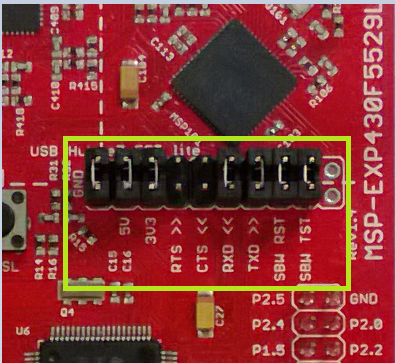SLAU533D September 2013 – April 2017
-
MSP430F5529 LaunchPad™ Development Kit (MSP‑EXP430F5529LP)
- Trademarks
- 1 Getting Started
- 2
Hardware
- 2.1 Block Diagram
- 2.2
Hardware Features
- 2.2.1 MSP430F5529
- 2.2.2 eZ-FET lite Onboard Emulator
- 2.2.3 Integrated Full-Speed USB Hub
- 2.2.4 Power
- 2.2.5 Clocking
- 2.2.6 Application (or "Backchannel") UART
- 2.2.7 Emulator and Target Isolation Jumper Block
- 2.2.8 Isolation Jumper Block: 3.3-V and 5-V Jumpers
- 2.2.9 Isolation Jumper Block: Emulator Connection and Application UART
- 2.3 Measure Current Draw of MSP430 MCU
- 2.4 Using an External Power Source
- 2.5 Using the eZ-FET lite Emulator With a Different Target
- 2.6 USB BSL Button
- 2.7 BoosterPack Plug-in Module Pinout
- 2.8 Design Files
- 2.9 Hardware Change Log
- 3
Software Examples
- 3.1 MSP430 Software Libraries: driverlib and the USB API
- 3.2 Viewing the Code
- 3.3 Example Project Software Organization
- 3.4 USB Configuration Files
- 3.5 Out-of-Box Experience: emulStorageKeyboard
- 3.6 Example: simpleUsbBackchannel
- 3.7 Starting Device Manager
- 4 Additional Resources
- 5 FAQs
- 6 Schematics
- Revision History
2.2.7 Emulator and Target Isolation Jumper Block
A set of ten jumpers is placed between the emulator and the F5529 target device. This is the isolation jumper block (see Figure 16 and Table 3). Individual functions on the isolation block are described in the following sections.
 Figure 16. Isolation Jumper Block
Figure 16. Isolation Jumper Block Table 3. Isolation Block Connections
| Jumper (from left to right) | Description |
|---|---|
| GND | Ground |
| 5V | 5-V VBUS, sourced from the USB host. The F5529 target needs this if attempting a USB connection with it. |
| 3V3 | 3.3-V rail, derived from VBUS with a dc-dc converter |
| RTS >> | Backchannel UART: Ready-To-Send, for hardware flow control. The target can use this to indicate whether it is ready to receive data from the host PC. The arrows indicate the direction of the signal. |
| CTS << | Backchannel UART: Clear-To-Send, for hardware flow control. The host PC (through the emulator) uses this to indicate whether it is ready to receive data. The arrows indicate the direction of the signal. |
| RXD << | Backchannel UART: the target F5529 receives data through this signal. The arrows indicate the direction of the signal. |
| TXD >> | Backchannel UART: the target F5529 sends data through this signal. The arrows indicate the direction of the signal. |
| SBW RST | Spy-Bi-Wire emulation: SBWTDIO data signal. This pin also functions as the RST signal (active low). |
| SBW TST | Spy-Bi-Wire emulation: SBWTCK clock signal. This pin also functions as the TST signal. |
| N/C | Not connected. Reserved. |